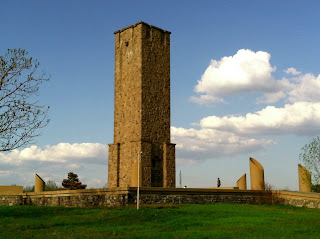This week I'm in the Georgian capital of Tbilisi, also called Tiflis. I was here eight years ago and Tbilisi's Old Town had undergone a remarkable transformation since then. While it still reflects its long period under Soviet rule, many historic buildings have been restored and the city has a very pleasant pedestrian zone with many lovely outdoor cafes, restaurants and bars. On my last visit, the city was being spruced up for an impending visit by George W. Bush. And the city now has a President George Bush Street (
http://www.freerepublic.com/focus/f-news/1485205/posts). Do you know any US cities that have streets named after George W. Bush?
I'm feeling lazy and won't write much on Tbilisi in this blog. But I will include several of my photos and provide a few links at the bottom for anyone who might be interested in post-soviet Georgia or in Georgian history and culture.
 |
| Map of Georgia showing the capital Tbilisi |
 |
| Restaurant: "KGB - Still Watching You" |
 |
| Cute Canopy on an Ethnic Restaurant |
 |
| One of Many Orthodox Churches |
 |
| Tbilisi Synagogue |
 |
| Mosque near City Baths |
 |
| Statue of St. George with Church in background |
 |
| Old fascade and porches under renovation |
 |
| Produce shop |
 |
| VIP Hotel, Tbilisi |
 |
| View from Old Town across the Mtkvari River |
 |
| Tbilisi Baths |
 |
| Houses on hillside leading up to Castle |
 |
| Restaurant near Mtkvari River |
 |
| Souvenir Shop |
 |
| Stelzer Haus German Restaurant |
 |
| View from Mtkvari Bridge Towards Old Town |
 |
| Cock of the Walk |
 |
| Interesting Door on a Night Club |
 |
| Old House With Classic Tbilisi Balcony on City Wall |
 |
| Folk Dancer Sculpture |
 |
| Office of the Georgian Orthodox Prelate |
 |
| Billboard for an Art Exhibit |
 |
| Old Georgian Architecture With Typical Balcony |
 |
| In Front of a Tourist Shop |
 |
| Pedestrian Zone with Restaurants |
That's the end of my photos and here are a few links on the Republic of Georgia, Georgian History and Tbilisi.
http://en.wikipedia.org/wiki/Tbilisi
Final note: During my stay I had conversations with several Georgians. When I asked those over 40 if they yearned for the old soviet days, without exception they said yes. I was very surprised and when I asked why, they typically said that life was simplier then with less worries, that people were closer and more friendly, and that the youth have become more aggressive and materialistic. In other words they seem to have liked the Nanny state and miss it. I don't quite know what to take from this but I found it interesting. I also have the impression that younger Georgians don't necessarily agree with the older ones.




























